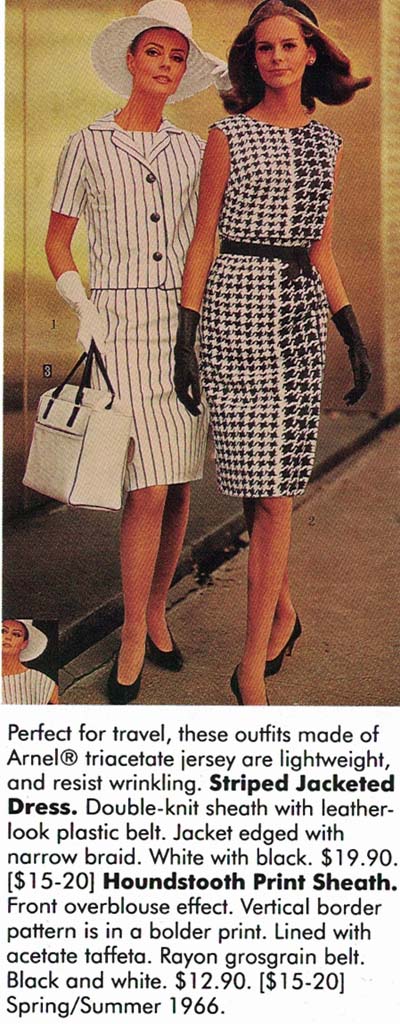Although synthetics began to make their way into American clothing after World War Two, I have always thought that they did not really triumph until the 1970s. All those leisure suits and disco outfits in bright, indestructible fabric seemed to mark the victory of polyester and its cousins over natural fibers.
However, a June 1966 issue of California Stylist, magazine of record for the West Coast garment industry, has made me question my assumption. Almost 2/3 of the 66 fashion ads mention synthetics. Fortrell had an eight page spread showing how different designers used the textile. An editorial tucked into the back offered this frightening prediction: “By 1970, it is believed, over one billion pounds of polyester fiber will be consumed annually.”
I began to wonder if the synthetic fiber industry hadn’t financed this particular issue of the magazine. To get another point of view, I thumbed through my Sears catalog reference books on the sixties hunting for fiber content. I found very little wool, a respectable amount of cotton (corduroy was well represented), but also quite a bit of nylon, acrylic, acetate, polyester, and blends. These books feature just a small sample of the company’s offerings, but there were enough synthetics to make me think that maybe California Stylist wasn’t all wrong.
Might there have been a generational split between those who wore synthetics and those who didn’t? The few ads in California Stylist featuring clothes that might have appealed to the older crowd—suit and coats instead of mini-skirts—were made in cotton and wool. But the Sears catalog doesn’t bear this out. There even the clothes for an older demographic were mainly made from synthetics.
So do I need to change my mind?




Very interesting. I remember as a child (early 60s) getting dress in Acrilan sweaters and bri-nylon trousers. My father had “easy care”, “drip dry” shirts that didn’t need ironing. My father was in the textile industry and moved to synthetics in the late 60s even for upholstery. Glass fibre, non-wovens and all types of nylon – the younger group thought this was progress especially in terms of durability and ease of washing.
I don’t know, I think a lot of it was embracing the new, but I do remember short lived nylon sheets (what a static start to the day that must have been). and also there was a time, nightwear could be made from ‘flammable’ fabric (I think special care labels had to be put in as a lot of home would still had open fires here – and I recall there was a court case here against a retailer/manufacturer about burns made worse from a nylon nightwear on a child) – I have the ann ladbury book Fabrics from the 70s and I still marvel at all the names.
Acetate, like rayon, is cellulose-based — i.e., derived from plant products. But polyesters and nylon are petroleum-based — like plastic. If you have ever tried to dye a polyester/cotton blend shirt, you’ll find that the cotton (a plant fiber) accepts a union dye, but the polyester does not — so you can only get a pastel color, no matter how dark the dye is. As I understand it — I’m no expert, just someone who’s done a lot of fabric dying — polyesters, like plastic, have to have dye introduced before being formed into thread or garbage cans, etc. In other words, the early synthetic fabrics like rayon and rayon acetate were essentially very different from the polyesters of the 1960’s and later. (Oddly, some nylon dyes quite easily….) Incidentally, washing polyester (petroleum-based) clothing releases tiny fragments of polyester/plastic into the oceans. Lots of it!
http://www.sciencemag.org/news/2011/10/laundry-lint-pollutes-worlds-oceans